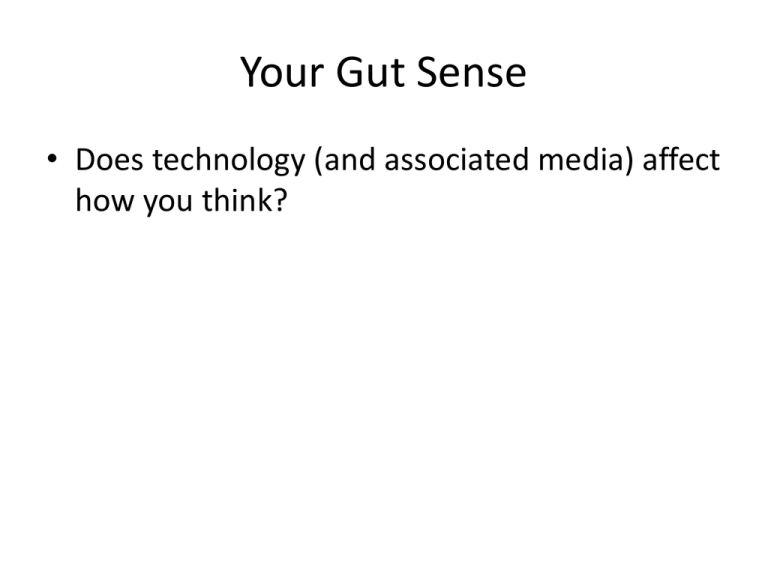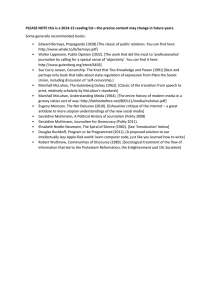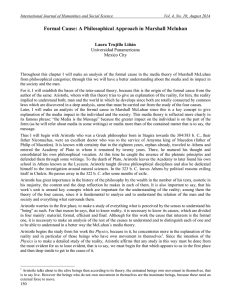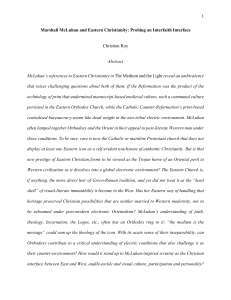"Televised Instruction" Presentation 102611
advertisement

Your Gut Sense • Does technology (and associated media) affect how you think? Instructional Television History of Ed Tech EDC&I 510 TV • First big communication technology to arrive with lots of fanfare, predictions – Initial predictions were grand: “People will watch theatre performances in their living rooms.” Rapid Spread of TV • Quick adoption by most US households • Reshapes entertainment industry • Many cultural artifacts generated very swiftly Merging into Everyday Life Developing a Visual Esthetic Pervasive and Long-Term Cultural Consequences • Removing previous barriers between – Men’s and women’s spheres of activity – Political elites and the masses (elimination of the “smoky room”) – Adults and children – Joshua Meyrowitz, No Sense of Place (1986) McLuhan’s Ideas • Canadian professor of Renaissance rhetoric • Most active in 1950s-70s • Famous for “the medium is the message” and “the global village” – But what does that mean…? • Understanding Media (1964) – “Hot” and “Cool” media Hot and Cool HOT • Extend one sense in high definition • User doesn’t have to work so hard to extract meaning (so: less mental engagement) – – – – Film Novels Radio Photography COOL • Extend several senses in lower definition • Takes effort for user to extract meaning (so: more mental engagement) – TV – Comics McLuhan’s Legacy • At death (1980), seen as something of a crank, media hypester, faux celebrity • Often not taken seriously as a communication, culture scholar • More recently, a rebound in interest (probably connected with Internet’s perceived effects) • Scholars with an education bent: Gavriel Salomon, David Olson, Michael Cole Thinking about Instructional Uses • TV came into classroom at nearly same time it won wide acceptance in homes • Variety of different purposes for use – Regular instruction, as teacher substitute, in distance ed, for ed in non-school settings, etc. • Fairly rapid evolution over 30 years (1950-80) – Hardware costs, development of cheap VCRs, etc. • Big government programs pushed development – Sesame Street, etc. Uses in Classroom • Early efforts at distance learning in higher ed – E.g.: Sunrise Semester – Popular, but very basic K-12 Classroom Use • Teacher shortage in early 1960s (baby boom) led to many experiments with using TV to “substitute for the teacher” • Typically closed-circuit from one room of a building to another • Not highly successful – parents were suspicious Distance Education • More successful, esp. in Great Britain with advent of Open University (1969) • Design, creation and distribution of materials (not just TV) was key • Worked best in situations with widely dispersed populations over big areas (Canada, Australia, USSR) Sesame Street • Part of “Great Society” efforts to improve education, lift kids from poverty • Backed by serious research efforts • Active employment of visual effects in service of learning Distinctive Characters, Settings • The Count What Mattered • Careful design (attention to prior learning, developmental stages, etc.) • Capitalization on associations already made via entertainment TV (pixilation, etc.) • Constant comparison and contrast with highproduction-value shows (commercials, etc.) • Value of self-confrontation – E.g., in teacher ed or any performance venue TV & Violence • Big national debate in 60s-70s • Surgeon General’s Report in 1972 attempted to settle question – (But still debated today) What Didn’t Matter So Much • Exposure to negative stimuli in entertainment TV (ads, violence, etc.) • “Standard” production values (color, animation, etc.) • Physical arrangement of viewing environments Questions that Faded with Time • Video as delivery vehicle for distance learning – Was very hardware-intensive in cf. to online • Complexity of delivering video signals – Spread of CCTV, then VCRs • Video as direct teacher substitute – Teacher supply and demand now better understood and monitored What Was Left Unanswered • Impact of long term exposure to mediated materials (attention span, etc.) – Cf. wide use of Channel One & what kids recall • “Print is hard, TV is easy” Are they? • “Visual literacy” What is it? – Cf. current interest in “Digital Storytelling” • Is the Medium the Message? Discussion Questions for Readings Chu & Schramm • Compared with the research on film, where does the research on TV match up? Where is it different? • What was “conventional instruction” in the studies summarized? • What were some of the underlying motivations for using TV in instruction? Clark (‘83, ’94) • “Mere vehicles…” Do you agree with this position (83, p. 445)? Why or why not? • Media attribute research (p. 451) – Are we still doing this sort of research today? Examples? • Invested mental effort (IME) work (p. 455) – Interaction with student ability levels – implications? • Efficiency vs. effectiveness (94, pp. 25-27) – Do you agree with Clark’s views? • Cf.: McLuhan’s ideas Clark (‘01) • Cognitive load and mental effort (267-279) – Implications for other applications, subjects • How to design to prevent “Overconfidence default” (280-82)? • Motivation processes (“yin” and “yang”) – picture of learners and their motivations that emerges? Salomon & Perkins • Effects with, of, and through technology – Examples of each? • Learning benefits of each? • “Effects through” and notion of activity systems: How does this match with current uses of social media? With support for learning ? Games and Learning (for next week, 11/2) • If you play games, what are the instructional qualities or value that you see in your favorite games? What do you learn when you play? • If you don't play games, research or find a game that you are interested in and play it (or think of a game you used to play). What are/were the instructional qualities that you experienced, if any? What did you learn while playing?









